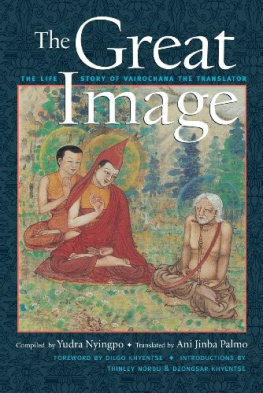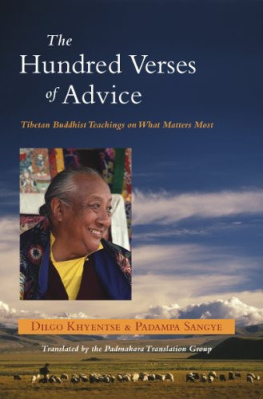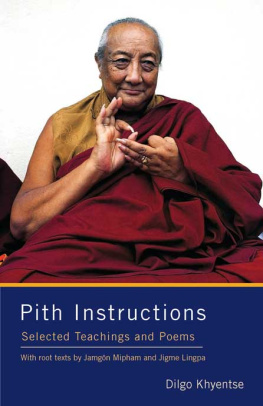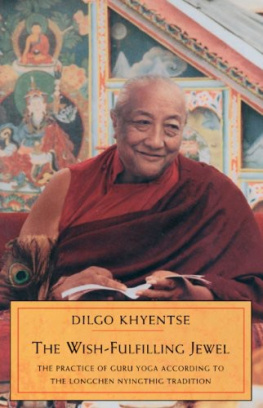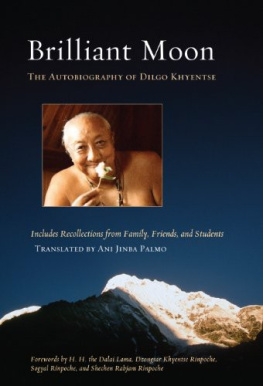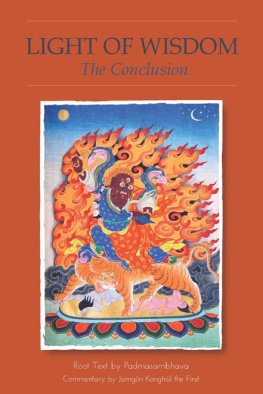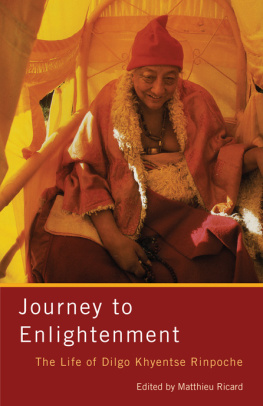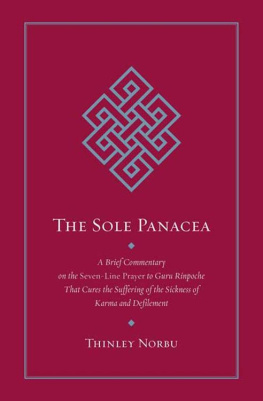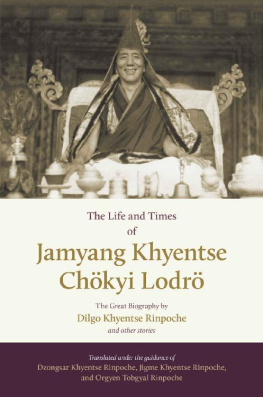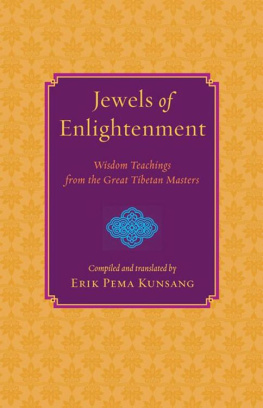The great translator Vairochana, crown ornament of all the Indian and Tibetan scholars, who was equal in realization and accomplishment to the second buddha from Oddiyana, extended the life force of the Buddhist teachings and living beings in Tibet in one lifetime.
Dilgo Khyentse Rinpoche
We should read biographies of sublime beings and ponder their qualities in order to receive their blessings and go beyond time and space as they have done.
Thinley Norbu Rinpoche
ABOUT THE BOOK
This book is the autobiography of the great scholar and translator Vairochana, as told to a group of his students near the end of his life in the eighth century. Responsible for bringing seminal Buddhist teachings to Tibet from India, his deep understanding of the Dharma was what enabled him to translate the essence of enlightened mind, conveyed in the Sanskrit texts, with great accuracy.
DILGO KHYENTSE RINPOCHE (19101991) was a highly accomplished meditation master, scholar, and poet, and a principal holder of the Nyingma lineage. His extraordinary depth of realization enabled him to be, for all who met him, a foundation of loving-kindness, wisdom, and compassion. A dedicated exponent of the nonsectarian Rime movement, Khyentse Rinpoche was respected by all schools of Tibetan Buddhism and taught many eminent teachers, including His Holiness the Dalai Lama. He tirelessly worked to uphold the Dharma through the publication of texts, the building of monasteries and stupas, and by offering instruction to thousands of people throughout the world. His writings in Tibetan fill twenty-five volumes.
Sign up to learn more about our books and receive special offers from Shambhala Publications.

Or visit us online to sign up at shambhala.com/eshambhala.

Shambhala Publications, Inc.
Horticultural Hall
300 Massachusetts Avenue
Boston, Massachusetts 02115
www.shambhala.com
2004 by Eugenie de Jong (Ani Jinba Palmo)
Thangka painting of Vairotsana with Yudra Nyingpo after the Translators Preface 1988 by Dugu Choegyal. Used with permission of the artist.
All rights reserved. No part of this book may be reproduced in any form or by any means, electronic or mechanical, including photocopying, recording, or by any information storage and retrieval system, without permission in writing from the publisher.
Library of Congress Cataloging-in-Publication Data
The great image: the life story of Vairochana the translator / translated by Ani Jinba Palmo; compiled by Yudra Nyingpo and other disciples.1st ed.
p. cm
Includes bibliographical references and index.
eISBN 978-0-8348-2418-8
ISBN 1-59030-069-6 (pbk. : alk. paper)
1. Vairocana, 8th cent. 2. Ri-ma-pa lamasChinaTibetBiography. 3. Rdzogs-chen (Ri-ma-pa)IndiaBiography. I. Palmo, Ani Jinba. II. Yudra Nyingpo.
BQ994.A437G74 2004
294.3923092dc22
2004010462
C ONTENTS

D ILGO K HYENTSE R INPOCHE
A S THE ILLUSTRIOUS Lochen Ngok, a great translator from the New Schools of Later Translations of Tibet, said:
Vairotsanas knowledge is equal to the sky,
Ka and Chok are like the sun and the moon, and
Rinchen Zangpo is like a star at dawn.
Before them I am like a butterfly.
Worthy of this praise, the great translator Vairotsana, crown ornament of all the Indian and Tibetan scholars, who was equal in realization and accomplishment to the second buddha from Oddiyana, extended the life force of the Buddhist teachings and living beings in Tibet in one lifetime. Understanding that his wondrous biography, the Great Image , is indispensable for spreading the light of the Dharma all over the world these days, the faithful Ani Jinba, born in Holland, translated this into English and checked it with many learned ones. Having seen the need for this publication, the old Dilgo Khyentse wrote this foreword. May it be virtuous.
Baudhanath, Nepal, 1989

A CCORDING TO THE Hinayana tradition, a previous incarnation of our Buddha Shakyamuni took the vow to attain enlightenment from his teacher, Shakya Thubpa Chenpo, many eons ago. According to the Mahayana tradition, one thousand princes took the bodhisattva vows from the enlightened Essence of Jewels at the time of King Tsipkyi Mukyo. Among these princes was a minister named Pollen of the Ocean, praised by buddhas and bodhisattvas as being as rare as a white lotus. Praying five hundred great prayers for the enlightenment of all beings, especially the beings of the kaliyuga , he later emanated as Buddha Shakyamuni. Within beings phenomena of time and space, Buddha Shakyamuni was born in this world, where he accomplished the twelve deeds according to general Buddhism. These included turning the wheel of Dharma with the Four Truths according to the Hinayana, the two truths according to the Mahayana, and the sole truth according to the absolute teaching. He showed the noble path by which the high realms could be achieved and the state of enlightenment ultimately attained. Just before Buddha entered parinirvana , his disciples requested, Buddha, you already spoke about the vehicles of the three guardians. Why did you not reveal the Absolute Vehicle of the spontaneously accomplished indivisibility of cause and result, which is without the need of searching elsewhere for buddhahood? The Buddha replied, I turned the wheel of the Causal Vehicle for those who wished for it. The Vajrayana method, which is the shortest path to enlightenment, will come in the future. After the Buddha entered parinirvana, his Hinayana teachings were maintained and spread by the Seven Patriarchs and his Mahayana teachings were held and spread by the Six Ornaments and the Two Supreme Ones. Also, from his miraculous wisdom mandala, the Buddha revealed various outer and inner tantric teachings, such as the Assembly of Secrets , to King Indrabhuti and his retinue in accordance with their keen faculties. As the Buddha predicted, many vidyadhara s and siddha s, such as the Eight Vidyadharas and Eighty-four Mahasiddhas, came at various times to various places, including the eight charnel grounds and Oddiyana, where he revealed the Vajrayana teachings. Eventually, as he himself had foretold, his teaching flourished toward the north in the snow mountain rosary of Tibet. During the reign of Lha Thothori Nyenshel, when the three holy images that came from the sky appeared with the prediction that their meaning would be revealed in future, the dawn of Buddhas teaching began. During the reign of King Songtsen Gampo, who was an emanation of Avalokiteshvara, the tradition of formulating profound Dharma terms in the Tibetan language was started by Thonmi Sambhota, and the laws of the ten holy virtues and sixteen worldly virtues were established, like the light that appears just before the sun is rising from behind the eastern mountains. During the reign of King Trisong Deutsen, who was an emanation of Manjushri, the sun of the Buddhas teaching had risen and was shining in the ten directions. King Trisong Deutsen was seventeen years old when he found the historical records of his ancestors and discovered that the Buddhas teachings had appeared once before in Tibet. Eager for the Buddhas teachings to flourish, he invited Shantarakshita and Padmasambhava to build Samye, the Sublime Palace of Inconceivable Self-Accomplishment. Upon completion of this monastery, King Trisong Deutsen gathered many sacred languages, including Sanskrit and Tibetan, for the purpose of translating all of the Buddhas teachings so that they would thrive throughout Tibet. But when Shantarakshita and Padmasambhava started to teach the Sanskrit version of taking refuge in the Triple Gem, the children did not pronounce it correctly and the king was disappointed.
Next page
